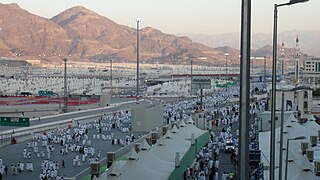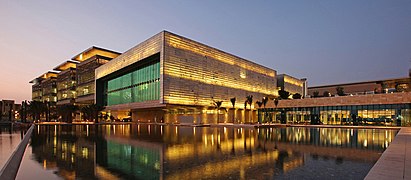Hejaz
Jump to navigationJump to search
|
Hejaz
ٱلْحِجَاز
Al-Ḥijāz
|
|
|---|---|
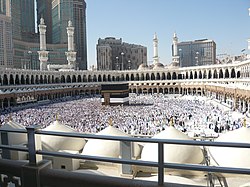
Above: Islam‘s holiest shrine, Al-Masjid Al-Ḥarām (The Sacred Mosque), which surrounds the Ka’bah (middle), in Mecca, land of Muhammad‘s birth and ancestry and an annual point of pilgrimage for millions of Muslims, 2010Below: Map of the Hejaz showing the cities of Mecca, Medina, Jeddah, Yanbu‘al-Bahr and Tabuk. The Saudi Arabian region is outlined in red and the 1923 Kingdom is in green.
|
|
 |
|
| Regions | Al-Bahah, Mecca, Medina and Tabuk |
The Hejaz (/hiːˈdʒæz, hɪˈ-/, also US: /hɛˈ-/; Arabic: ٱلْحِجَاز, romanized: al-Ḥijāz, lit. ‘the Barrier’, Hejazi pronunciation: [alħɪˈdʒaːz]) is a region in the west of Saudi Arabia. The name of the region is derived from the Arabic root Ḥ-J-Z, meaning “to separate,”[1] and it is so called as it separates the land of the Najd in the east from the land of Tihāmah in the west. It is also known as the “Western Province.”[2] It is bordered in the west by the Red Sea, in the north by Jordan, in the east by the Najd, and in the south by the ‘Asir Region.[3] Its largest city is Jeddah, the second largest city in Saudi Arabia, with Mecca and Medina being the fourth and fifth largest cities respectively in Saudi Arabia.
The Hejaz is significant for being the location of the Islamic holy cities of Mecca[4] and Medina,[5][6][7] the first and second holiest sites in Islam, respectively. As the site of the two holiest sites in Islam, the Hejaz has significance in the Arab and Islamic historical and political landscape. The Hejaz is the most populated region in Saudi Arabia,[8] containing 35% of the population of Saudi Arabia.[9] Arabic is the predominant language as in the rest of Saudi Arabia, with Hejazi Arabic being most widely spoken dialect in the region. Hejazi Saudis are of ethnically diverse origins.[10]
The region is the birthplace of the Islamic Ummah (Community) of Muhammad, who was born in Mecca, which is locally considered to have been founded by the Biblical figures Abraham, Hagar and Ishmael.[11][12] The area became part of his empire through the early Muslim conquests, and it formed part of successive caliphates, first the Rashidun caliphate, followed by the Umayyad caliphate, and finally the Abbasid caliphate. The Ottoman Empire held partial control over the area; after its dissolution, an independent Kingdom of Hejaz existed briefly in 1925 before being conquered by the neighbouring Sultanate of Nejd, creating the Kingdom of Hejaz and Nejd.[13] In September 1932, the Kingdom of Hejaz and Nejd joined the Saudi dominions of Al-Hasa and Qatif, creating the unified Kingdom of Saudi Arabia.[14][15]
The Hejaz is the most cosmopolitan region in the Arabian Peninsula.[10] People of Hejaz are compromised of Arab tribes (Bedouin) and people of foreign ancestries (Urban), arguably causing a threat to the historical culture of the region.
Timeline[edit]
Prehistoric or ancient times[edit]

The city of Al-`Ula in 2012. The city’s archaeological district is in the foreground, with the Hijaz Mountains in the background.
One or possibly two megalithic dolmen have been found in the Hijaz.[16]
The Hejaz includes both the Mahd adh-Dhahab (“Cradle of the Gold”) (23°30′13″N 40°51′35″E) and a water source, now dried out, that used to flow 600 miles (970 km) north east to the Persian Gulf via the Wādi Al-Rummah and Wādi Al-Bātin system. Archaeological research led by of Boston University and the University of Qassim indicates that the river system was active in 8000 BCE[citation needed] and 2500–3000 BCE.[17]
The northern part of the Hejaz was part of the Roman province of Arabia Petraea.[18]
Al-Hijr Archaeological Site[edit]
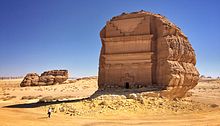
Al-Ḥijr or Madā’in Ṣāliḥ (“Cities of Saleh“)
Saudi Arabia’s first World Heritage Site that was recognized by the United Nations Educational, Scientific and Cultural Organization is that of Al-Hijr. The name “Al-Ḥijr” (“The Land of Stones” or “The Rocky Place”) occurs in the Qur’an,[19] and the site is known for having structures carved into rocks, similar to Petra.[20][21] Construction of the structures is credited to the people of Thamud. The location is also called “Madā’in Ṣāliḥ” (“Cities of Saleh”),[22][23][24][25][26][27] as it is speculated to be the city in which the Islamic Nabī (Prophet) Salih was sent to the people of Thamud. After the disappearance of Thamud from Mada’in Saleh, it came under the influence of other people, such as the Nabataeans, whose capital was Petra. Later, it would lie in a route used by Muslim Pilgrims going to Mecca.[18][28][29][30]
Era of Abraham and Ishmael[edit]
According to Arab and Islamic sources, the civilization of Mecca started after Ibrāhīm (Abraham) brought his son Ismāʿīl (Ishmael) and wife Hājar (Hagar) here, for the latter two to stay. Some people from the Yemeni tribe of Jurhum settled with them, and Isma’il reportedly married two women, one after divorcing another, at least one of them from this tribe, and helped his father to construct or re-construct the Ka’bah (‘Cube’),[31][32][33] which would have social, religious, political and historical implications for the site and region.[11][12]
For example, in Arab or Islamic belief, the tribe of Quraysh would descend from Isma’il ibn Ibrahim, be based in the vicinity of the Ka’bah,[34] and include Muhammad ibn Abdullah ibn Abdul-Muttalib ibn Hashim ibn Abd Manaf. From the Period of Jāhiliyyah (‘Ignorance’) to the days of Muhammad, the often-warring Arab tribes would cease their hostilities during the time of Pilgrimage, and go on pilgrimage to Mecca, as inspired by Ibrāhim.[33] It was during such an occasion that Muhammad met some Medinans who would allow him to migrate to Medina, to escape persecution by his opponents in Mecca.[35][36][37][38][39][40]
Era of Muhammad[edit]

Muhammad’s Mosque in Medina, his place-of-residence after the Hijrah (Migration) from Mecca, 2010
As the land of Mecca[4] and Medina,[5][6][7] the Hejaz was where Muhammad was born, and where he founded a Monotheistic Ummah of followers, bore patience with his foes or struggled against them, migrated from one place to another, preached or implemented his beliefs, lived and died. Given that he had both followers and enemies here, a number of battles or expeditions were carried out in this area, like those of Al-Aḥzāb (“The Confederates”), Badr[41] and Ḥunayn. They involved both Meccan companions, such as Hamzah ibn Abdul-Muttalib, Ubaydah ibn al-Harith and Sa`d ibn Abi Waqqas, and Medinan companions.[5][39][40][42][43] The Hijaz fell under Muhammad’s influence as he emerged victorious over his opponents, and was thus a part of his empire.[11][35][37][38][44][45][46]
Subsequent history[edit]
Due to the presence of the two holy cities in the Hejaz, the region was ruled by numerous empires. The Hejaz was at the center of the Rashidun Caliphate, in particular whilst its capital was Medina from 632 to 656 ACE. The region was then under the control of regional powers such as Egypt and the Ottoman Empire, throughout much of its later history.
Brief independence[edit]
In 1916, Sharif Hussein ibn Ali proclaimed himself King of an independent Hejaz, as a result of the McMahon–Hussein Correspondence. The ensuing Arab Revolt overthrew the Ottoman Empire. In 1924, however, Ibn Ali was forced into exile by Ibn Saud of the Najd.[citation needed]
In modern Saudi Arabia[edit]
At first, Ibn Saud ruled the two as separate units, though they became known as the Kingdom of Hejaz and Nejd. Later they were formally combined as the Kingdom of Saudi Arabia.[citation needed]
-
Flag of the Rashidun Caliphate (632–661)
-
Flag of the Umayyad Caliphate (661–750)
-
Flag of the Abbasid Caliphate (750–1258)
-
Flag of the Fatimid Caliphate (909–1171)
-
Flag of the Ayyubid dynasty (1171–1254)
-
Flag of the Mamluk Sultanate (1254–1517)
-
Flag of the Ottoman Empire (1517–1916)
-
Flag of the Kingdom of Hejaz (1916–1925)
-
Flag of the Kingdom of Saudi Arabia (1925–present)
Cities[edit]
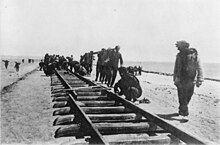
Workers laying tracks for the Hejaz Railway near Tabuk, 1906
Geography[edit]
The region is located along the Red Sea Rift. It is also known for its darker, more volcanic sand. Depending on the previous definition, the Hejaz includes the high mountains of Sarawat, which topographically separate the Najd from Tehamah. Bdellium plants are also abundant in the Hijaz.
International tourism development[edit]
As a component of Saudi Vision 2030, a 28,000 square kilometer tourism destination is under development[53] on the Red Sea coast between the towns of Umluj (25.0500°N 37.2651°E) and Al-Wajh (26.2366°N 36.4689°E), in the northern section of the Hejazi coast. The project will involve “the development of 22 of the 90+ islands”[54] that lie along the coast to create a “fully integrated luxury mixed-use destination.”[55] and will be “governed by laws on par with international standards”.[56]
People of the Hejaz[edit]
People of Hejaz, who feel particularly connected to the holy places of Mecca and Medina, have probably the most strongly articulated identity of any regional grouping in Saudi Arabia.[57]
Most people of Hejaz are Sunni of Maliki rite with a Shia minority in the cities of Medina, Mecca and Jeddah. Many consider themselves more cosmopolitan because Hejaz was for centuries a part of the great empires of Islam from the Umayyads to the Ottomans.[58]
Gallery[edit]
-
The camp of Mina on the outskirts of Mecca, where Muslim pilgrims gather for the Ḥajj (Greater Pilgrimage). Masjid Al-Khayf is visible to the right.
-
Pilgrims gathering at the plain of Mount Arafat
-
Mount Uhud in the area of Madinah
-
Al-Bahah City, located 2,155 m (7,070 ft) above sea level
-
King Abdullah University of Science and Technology (KAUST) campus at night
-
Beach promenade in Al-Wajh
Notable Hejazis[edit]
Al-Abwa’[edit]
- Musa al-Kadhim ibn Ja‘far al-Sadiq, descendant of Muhammad[59]
Mecca[edit]
Pre-6th century CE[edit]
- Qusai ibn Kilab ibn Murrah ibn Ka’b ibn Lu’ayy ibn Ghalib ibn Fihr ibn Malik ibn An-Nadr ibn Kinanah[60] ibn Khuzaymah ibn Mudrikah ibn Ilyas ibn Mudar ibn Nizar ibn Ma’ad ibn Adnan the descendant of Isma’il ibn Ibrahim ibn Azar ibn Nahor ibn Serug ibn Reu ibn Peleg ibn Eber ibn Shelakh,[61][62] Chief of the Tribe of Quraysh, and an ancestor of Muhammad[63]
- Qusai’s son Abd-al-Dar[64][65] the father of Uthman the father of Abdul-Uzza the father of Barrah the maternal grandmother of Muhammad
- Abd Manaf ibn Qusai, paternal ancestor of Muhammad[66]
- Abdul-Uzza, son of Qusai, and an ancestor of Barrah bint Abdul-Uzza
- Hashim, son of Abd Manaf, paternal great-grandfather of Muhammad, and the progenitor of Banu Hashim in the Tribe of Quraysh
- Hubbah bint Hulail ibn Hubshiyyah ibn Salul ibn Ka‘b ibn Amr al-Khuza’i, wife of Qusai, and an ancestor of Muhammad
- Atikah bint Murrah ibn Hilal ibn Falij ibn Dhakwan, wife of Abd Manaf, and an ancestor of Muhammad[66]
Since[edit]
- Abu al-Qasim Muhammad ibn Abdullah ibn Abdul-Muttalib[39][40]
- Abu Bakr[39][40] Abdullah ibn Uthman Abu Quhafah ibn Amir ibn Amr ibn Ka’b ibn Sa’d ibn Taym ibn Murrah ibn Ka’b, father-in-law of Muhammad, and Caliph
- Umar ibn Al-Khattab[39][40] ibn Nufayl ibn Abdul-Uzza the descendant of Adi ibn Ka’b ibn Lu’ayy, father-in-law of Muhammad, and Caliph
- Ali ibn Abi Talib,[39][40] cousin and son-in-law of Muhammad, and Caliph
- Hamzah, son of Abdul-Muttalib, and a paternal uncle of Muhammad, and other Muhajirun[5] or Meccan followers of Muhammad, including Ubaydah and Sa’d[39][40][42]
- Abu Talib, son of Abdul-Muttalib,[39][40] Chief of Banu Hashim, paternal uncle of Muhammad, and the father of Ali
- Abd al-Muttalib ibn Hashim,[39][40] Chief of Bani Hashim, and the paternal grandfather of Muhammad
- Khadijah bint Khuwaylid[67] ibn Asad ibn Abdul-Uzza ibn Qusai, and other Meccan wives of Muhammad
- Fatimah,[67] other daughters of Muhammad, and other Muhajir women
- Umm Ammar Sumayyah bint Khayyat, wife of Yasir ibn Amir ibn Malik al-Ansi, believed to be the first martyr from the followers of Muhammad
- Aminah[39][40][63] bint Wahb ibn Abd Manaf ibn Zuhrah ibn Kilab ibn Murrah, wife of Abdullah, and the mother of Muhammad
Medina[edit]
Pre-6th century CE[edit]
- Salmah, daughter of Amr, wife of Hashim, and a great-grandmother of Muhammad[66]
Since[edit]
- Caliph Hasan,[39][40] and other sons of Ali and grandsons of Muhammad born in Medina[67]
- Caliph Umar ibn Abdul-Aziz ibn Marwan ibn Al-Hakam ibn Abi al-‘As ibn Umayyah ibn Abd Shams ibn Abd Manaf ibn Qusai, great-grandson of Umar ibn Al-Khattab
- Hasan of Basra
- Muhammad al-Baqir ibn Ali Zaynul-Abidin, grandson of Hasan and Husayn the grandsons of Muhammad[67]
- Zayd ibn Ali Zaynul-Abidin ibn Husayn ibn Fatimah bint Muhammad, half-brother of Muhammad al-Baqir
- Ansari women[39][40]
- Ja’far al-Sadiq ibn Muhammad al-Baqir[67]
- Malik the son of Anas ibn Malik ibn Abi Amir al-Asbahi (not Anas the companion of Muhammad)
- Ali al-Ridha ibn Musa al-Kadhim ibn Ja’far al-Sadiq[67]
- Fatimah bint Musa ibn Ja’far,[68] sister of Ali al-Ridha
- Abu Ali Muhammad al-Jawad ibn Ali al-Ridha[67]
Ta’if[edit]
6th–7th centuries CE[edit]
- Uthman ibn Affan[39][40] ibn Abu al-‘As ibn Umayyah ibn Abd Shams ibn Abd Manaf, son-in-law of Muhammad, and Caliph
- Urwah ibn Mas’ud,[35] Chief of Banu Thaqif
- Nafi ibn al-Harith, Physician[69]
Since[edit]
- Sharif Ali ibn Ajlan ibn Rumaithah ibn Muhammad, son-in-law and successor of Sultan Ahmad of Brunei, father of Sultan Sulaiman, and a descendant of Muhammad[70]










